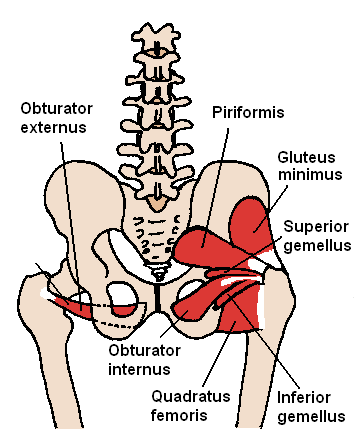The piriformis muscle (PM) is well-known in medicine as a significant muscle of the posterior hip. It is a muscle that has a role in controlling hip joint rotation and abduction, and it is also a muscle made famous due to its inversion of action in rotation. The PM also garners attention due to its role in piriformis syndrome, a condition implicated as a potential source of pain and dysfunction.
Piriformis syndrome can be defined as a medical condition in which the piriformis muscle, located in the buttock region, spasms and causes buttock pain. The Sciatic Nerve may be irritated by the interaction between the SN and the PM producing posterior hip pain down the posterior thigh, imitating ‘sciatica’.
Complaints of buttock pain with the referral of symptoms are not unique to the Piriformis Muscle. Symptoms are widespread with more clinically evident back pain syndromes. It has been indicated that piriformis syndrome is accountable for 5-6 percent of cases of sciatica. In the majority of instances, it happens in middle-aged individuals and is far more prevalent in women.

Contents
Anatomy: Piriformis
The PM originates on the anterior surface of the sacrum and is anchored to it by three fleshy attachments between the first, second, third and fourth anterior sacral foramina. Occasionally its origin may be so broad that it joins the capsule of the sacroiliac joint above and with the sacrotuberous and/or sacrospinous ligament below.
PM is a thick and bulky muscle, and as it passes out of the pelvis through the greater sciatic foramen, it divides the foramen into the suprapiriform and infra-piriform foramina. As it courses anterolaterally through the greater sciatic foramen, it tapers out to form a tendon that is attached to the superior-medial surface of the greater trochanter, commonly blending with the common tendon of the obturator internus and Gemelli’s muscles.
The nerves and blood vessels in the suprapiriform foramen are the superior gluteal nerve and vessels, and in the infra-piriform fossa are the inferior gluteal nerves and vessels and the sciatic nerve (SN). Due to its large volume in the greater sciatic foramen, it has the potential to compress the numerous vessels and nerves that exit the pelvis.
PM is closely associated with the other short hip rotators that lie inferior such as the superior gemellus, obturator internus, inferior gemellus, and obturator externus. The primary difference between the PM and other short rotators is the relationship to the SN. The PM passes posterior to the nerve whereas the other obturator pass anterior.
Cause: Piriformis Syndrome
Piriformis Syndrome may be caused by or related to three primary causative factors;
1. Tight and shortened muscle fibers precipitated by muscle overuse such as squat and lunge movements in external rotation, or direct trauma. This increases the girth of the PM during contraction, and may the source of the compression/entrapment.
2. Entrapment of the nerve.
3.Sacroiliac Joint Dysfunction (SI Joint Pain) causing PM spasm.
Symptoms: Piriformis Syndrome
 Typical symptoms of piriformis syndrome include:
Typical symptoms of piriformis syndrome include:
- A tight or cramping sensation in the buttock and/or hamstring.
- Gluteal pain.
- Calf pain.
- Aggravation from sitting and squatting, especially if the trunk is inclined forward or the leg is crossed over the unaffected leg.
- Possible peripheral nerve signs such as pain and paraesthesia in the back, groin, buttocks, perineum, back of the thigh.
Treatment: Piriformis Syndrome
 When it is believed that piriformis syndrome exists and the clinician feels that a diagnosis has been made, the treatment will usually depend on the suspected cause. If the PM is tight and in spasm then initially conservative treatment will focus on stretching and massaging the tight muscle to remove the PM as being the source of the pain.
When it is believed that piriformis syndrome exists and the clinician feels that a diagnosis has been made, the treatment will usually depend on the suspected cause. If the PM is tight and in spasm then initially conservative treatment will focus on stretching and massaging the tight muscle to remove the PM as being the source of the pain.
If this fails, then the following has been suggested:
- Local anesthetic block performed by anesthesiologists who have expertise in pain management.
- Steroid injections into the PM.
- Botulinum injections into the PM.
- Nerve Surgery.
Therapist-directed interventions such as stretching of the PM and direct trigger point massage have always been advocated. PM stretches are done in positions of hip flexion greater than 90 degrees, adduction, and external rotation to utilize the inversion of action effect of the PM to isolate the stretch to this muscle independent of the other hip external rotators.
Conclusion: Piriformis Syndrome
 The piriformis muscle is a really strong and powerful muscle that runs from the sacrum into the femur. It runs beneath gluteal muscles the nerve travels beneath them. If this muscle goes into spasm, then the nerve creates radiating pain, numbness, tingling, or burning out of the buttocks to the leg and foot. Other people develop the syndrome while dealing with chronic low back pain.
The piriformis muscle is a really strong and powerful muscle that runs from the sacrum into the femur. It runs beneath gluteal muscles the nerve travels beneath them. If this muscle goes into spasm, then the nerve creates radiating pain, numbness, tingling, or burning out of the buttocks to the leg and foot. Other people develop the syndrome while dealing with chronic low back pain.
Activities and motions that cause the piriformis muscle to contract further compress the sciatic nerve, causing pain. This muscle contracts once we squat, or stand, walk, go up steps. It tends to tighten when we sit at any position for more than 20 to 30 minutes.
Individuals who have a history of chronic low back pain frequently assume that their radiating sciatic pain is traceable to their lower spine. Their history of disc herniations, or sprains, strains have taught them to assume that it will go away like normal and that the pain is out of their spine. It is just when the pain doesn’t respond as usual that individuals seek therapy, thus delaying their recovery.
Sciatica Pain
Professional Scope of Practice *
The information herein on "Piriformis Treatment" is not intended to replace a one-on-one relationship with a qualified health care professional or licensed physician and is not medical advice. We encourage you to make healthcare decisions based on your research and partnership with a qualified healthcare professional.
Blog Information & Scope Discussions
Our information scope is limited to Chiropractic, musculoskeletal, physical medicines, wellness, contributing etiological viscerosomatic disturbances within clinical presentations, associated somatovisceral reflex clinical dynamics, subluxation complexes, sensitive health issues, and/or functional medicine articles, topics, and discussions.
We provide and present clinical collaboration with specialists from various disciplines. Each specialist is governed by their professional scope of practice and their jurisdiction of licensure. We use functional health & wellness protocols to treat and support care for the injuries or disorders of the musculoskeletal system.
Our videos, posts, topics, subjects, and insights cover clinical matters, issues, and topics that relate to and directly or indirectly support our clinical scope of practice.*
Our office has reasonably attempted to provide supportive citations and has identified the relevant research study or studies supporting our posts. We provide copies of supporting research studies available to regulatory boards and the public upon request.
We understand that we cover matters that require an additional explanation of how it may assist in a particular care plan or treatment protocol; therefore, to further discuss the subject matter above, please feel free to ask Dr. Alex Jimenez, DC, or contact us at 915-850-0900.
We are here to help you and your family.
Blessings
Dr. Alex Jimenez DC, MSACP, RN*, CCST, IFMCP*, CIFM*, ATN*
email: coach@elpasofunctionalmedicine.com
Licensed as a Doctor of Chiropractic (DC) in Texas & New Mexico*
Texas DC License # TX5807, New Mexico DC License # NM-DC2182
Licensed as a Registered Nurse (RN*) in Florida
Florida License RN License # RN9617241 (Control No. 3558029)
Compact Status: Multi-State License: Authorized to Practice in 40 States*
Dr. Alex Jimenez DC, MSACP, RN* CIFM*, IFMCP*, ATN*, CCST
My Digital Business Card

